
curategpt
LLM-driven curation assist tool
Stars: 81
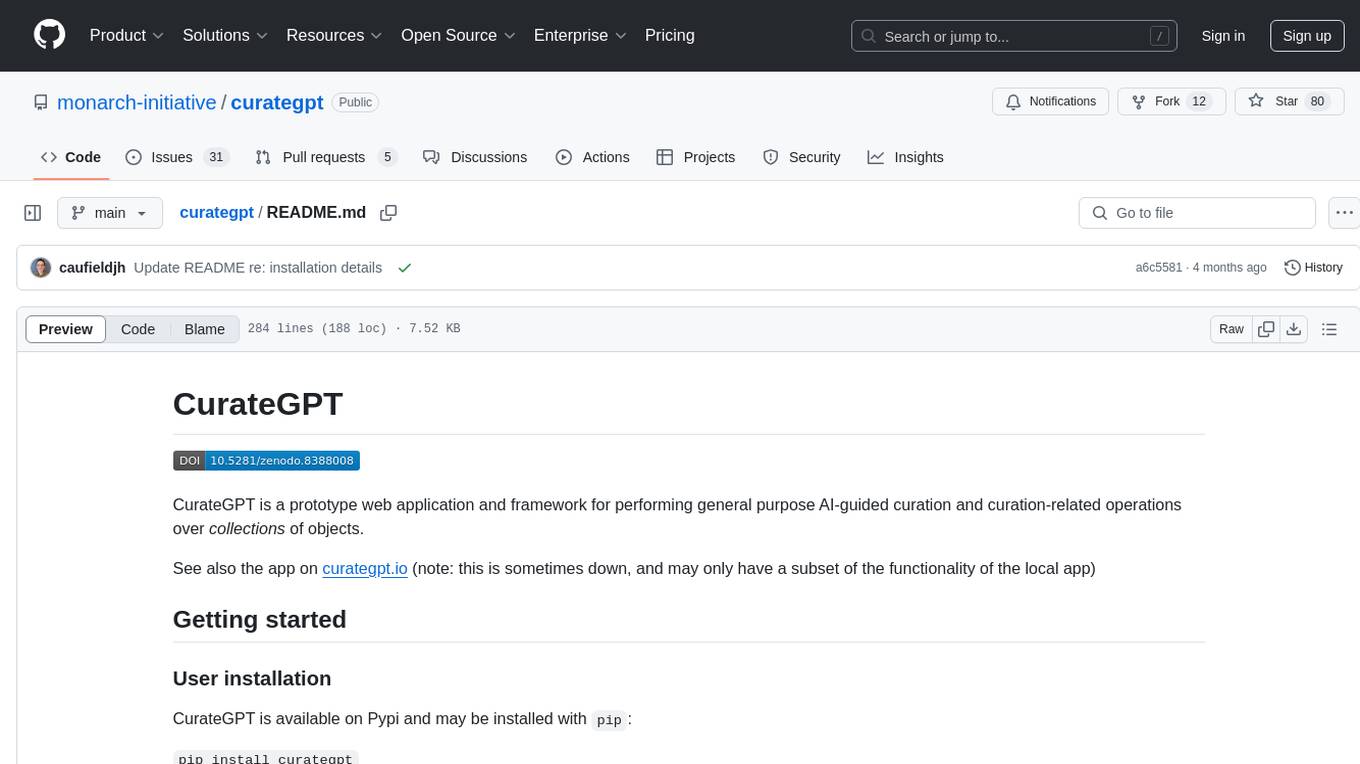
CurateGPT is a prototype web application and framework designed for general purpose AI-guided curation and curation-related operations over collections of objects. It provides functionalities for loading example data, building indexes, interacting with knowledge bases, and performing tasks such as chatting with a knowledge base, querying Pubmed, interacting with a GitHub issue tracker, term autocompletion, and all-by-all comparisons. The tool is built to work best with the OpenAI gpt-4 model and OpenAI ada-text-embedding-002 for embedding, but also supports alternative models through a plugin architecture.
README:
CurateGPT is a prototype web application and framework for performing general purpose AI-guided curation and curation-related operations over collections of objects.
See also the app on curategpt.io (note: this is sometimes down, and may only have a subset of the functionality of the local app)
CurateGPT is available on Pypi and may be installed with pip:
pip install curategpt
You will first need to install Poetry.
Then clone this repo.
git clone https://github.com/monarch-initiative/curategpt.git
cd curategpt
and install the dependencies:
poetry install
In order to get the best performance from CurateGPT, we recommend getting an OpenAI API key, and setting it:
export OPENAI_API_KEY=<your key>
(for members of Monarch: ask on Slack if you would like to use the group key)
CurateGPT will also work with other large language models - see "Selecting models" below.
You initially start with an empty database. You can load whatever you like into this
database! Any JSON, YAML, or CSV is accepted.
CurateGPT comes with wrappers for some existing local and remote sources, including
ontologies. The Makefile contains some examples of how to load these. You can
load any ontology using the ont-<name> target, e.g.:
make ont-cl
This loads CL (via OAK) into a collection called ont_cl
Note that by default this loads into a collection set stored at stagedb, whereas the app works off
of db. You can copy the collection set to the db with:
cp -r stagedb/* db/
You can then run the streamlit app with:
make app
CurateGPT depends on vector database indexes of the databases/ontologies you want to curate.
The flagship application is ontology curation, so to build an index for an OBO ontology like CL:
make ont-cl
This requires an OpenAI key.
(You can build indexes using an open embedding model, modify the command to leave off
the -m option, but this is not recommended as currently oai embeddings seem to work best).
To load the default ontologies:
make all
(this may take some time)
To load different databases:
make load-db-hpoa
make load-db-reactome
You can load an arbitrary json, yaml, or csv file:
curategpt view index -c my_foo foo.json
(you will need to do this in the poetry shell)
To load a GitHub repo of issues:
curategpt -v view index -c gh_uberon -m openai: --view github --init-with "{repo: obophenotype/uberon}"
The following are also supported:
- Google Drives
- Google Sheets
- Markdown files
- LinkML Schemas
- HPOA files
- GOCAMs
- MAXOA files
- Many more
- See notebooks for examples.
Currently this tool works best with the OpenAI gpt-4 model (for instruction tasks) and OpenAI ada-text-embedding-002 for embedding.
CurateGPT is layered on top of simonw/llm which has a plugin architecture for using alternative models. In theory you can use any of these plugins.
Additionally, you can set up an openai-emulating proxy using litellm.
The litellm proxy may be installed with pip as pip install litellm[proxy].
Let's say you want to run mixtral locally using ollama. You start up ollama (you may have to run ollama serve first):
ollama run mixtral
Then start up litellm:
litellm -m ollama/mixtral
Next edit your extra-openai-models.yaml as detailed in the llm docs:
- model_name: ollama/mixtral
model_id: litellm-mixtral
api_base: "http://0.0.0.0:8000"
You can now use this:
curategpt ask -m litellm-mixtral -c ont_cl "What neurotransmitter is released by the hippocampus?"But be warned that many of the prompts in curategpt were engineered
against openai models, and they may give suboptimal results or fail
entirely on other models. As an example, ask seems to work quite
well with mixtral, but complete works horribly. We haven't yet
investigated if the issue is the model or our prompts or the overall
approach.
Welcome to the world of AI engineering!
curategpt --helpYou will see various commands for working with indexes, searching, extracting, generating, etc.
These functions are generally available through the UI, and the current priority is documenting these.
curategpt ask -c ont_cl "What neurotransmitter is released by the hippocampus?"
may yield something like:
The hippocampus releases gamma-aminobutyric acid (GABA) as a neurotransmitter [1](#ref-1).
...
## 1
id: GammaAminobutyricAcidSecretion_neurotransmission
label: gamma-aminobutyric acid secretion, neurotransmission
definition: The regulated release of gamma-aminobutyric acid by a cell, in which the
gamma-aminobutyric acid acts as a neurotransmitter.
...
curategpt view ask -V pubmed "what neurons express VIP?"
curategpt ask -c gh_obi "what are some new term requests for electrophysiology terms?"
curategpt complete -c ont_cl "mesenchymal stem cell of the apical papilla"
yields
id: MesenchymalStemCellOfTheApicalPapilla
definition: A mesenchymal cell that is part of the apical papilla of a tooth and has
the ability to self-renew and differentiate into various cell types such as odontoblasts,
fibroblasts, and osteoblasts.
relationships:
- predicate: PartOf
target: ApicalPapilla
- predicate: subClassOf
target: MesenchymalCell
- predicate: subClassOf
target: StemCell
original_id: CL:0007045
label: mesenchymal stem cell of the apical papillaYou can compare all objects in one collection
curategpt all-by-all --threshold 0.80 -c ont_hp -X ont_mp --ids-only -t csv > ~/tmp/allxall.mp.hp.csv
This takes 1-2s, as it involves comparison over pre-computed vectors. It reports top hits above a threshold.
Results may vary. You may want to try different texts for embeddings (the default is the entire json object; for ontologies it is concatenation of labels, definition, aliases).
sample:
HP:5200068,Socially innappropriate questioning,MP:0001361,social withdrawal,0.844015132437909
HP:5200069,Spinning,MP:0001411,spinning,0.9077306606290237
HP:5200071,Delayed Echolalia,MP:0013140,excessive vocalization,0.8153252835818089
HP:5200072,Immediate Echolalia,MP:0001410,head bobbing,0.8348177036912526
HP:5200073,Excessive cleaning,MP:0001412,excessive scratching,0.8699103725005582
HP:5200104,Abnormal play,MP:0020437,abnormal social play behavior,0.8984862078522344
HP:5200105,Reduced imaginative play skills,MP:0001402,decreased locomotor activity,0.85571629684631
HP:5200108,Nonfunctional or atypical use of objects in play,MP:0003908,decreased stereotypic behavior,0.8586700411012859
HP:5200129,Abnormal rituals,MP:0010698,abnormal impulsive behavior control,0.8727804272023427
HP:5200134,Jumping,MP:0001401,jumpy,0.9011393233129765
Note that CurateGPT has a separate component for using an LLM to evaluate candidate matches (see also https://arxiv.org/abs/2310.03666); this is not enabled by default, this would be expensive to run for a whole ontology.
For Tasks:
Click tags to check more tools for each tasksFor Jobs:
Alternative AI tools for curategpt
Similar Open Source Tools

curategpt
CurateGPT is a prototype web application and framework designed for general purpose AI-guided curation and curation-related operations over collections of objects. It provides functionalities for loading example data, building indexes, interacting with knowledge bases, and performing tasks such as chatting with a knowledge base, querying Pubmed, interacting with a GitHub issue tracker, term autocompletion, and all-by-all comparisons. The tool is built to work best with the OpenAI gpt-4 model and OpenAI ada-text-embedding-002 for embedding, but also supports alternative models through a plugin architecture.
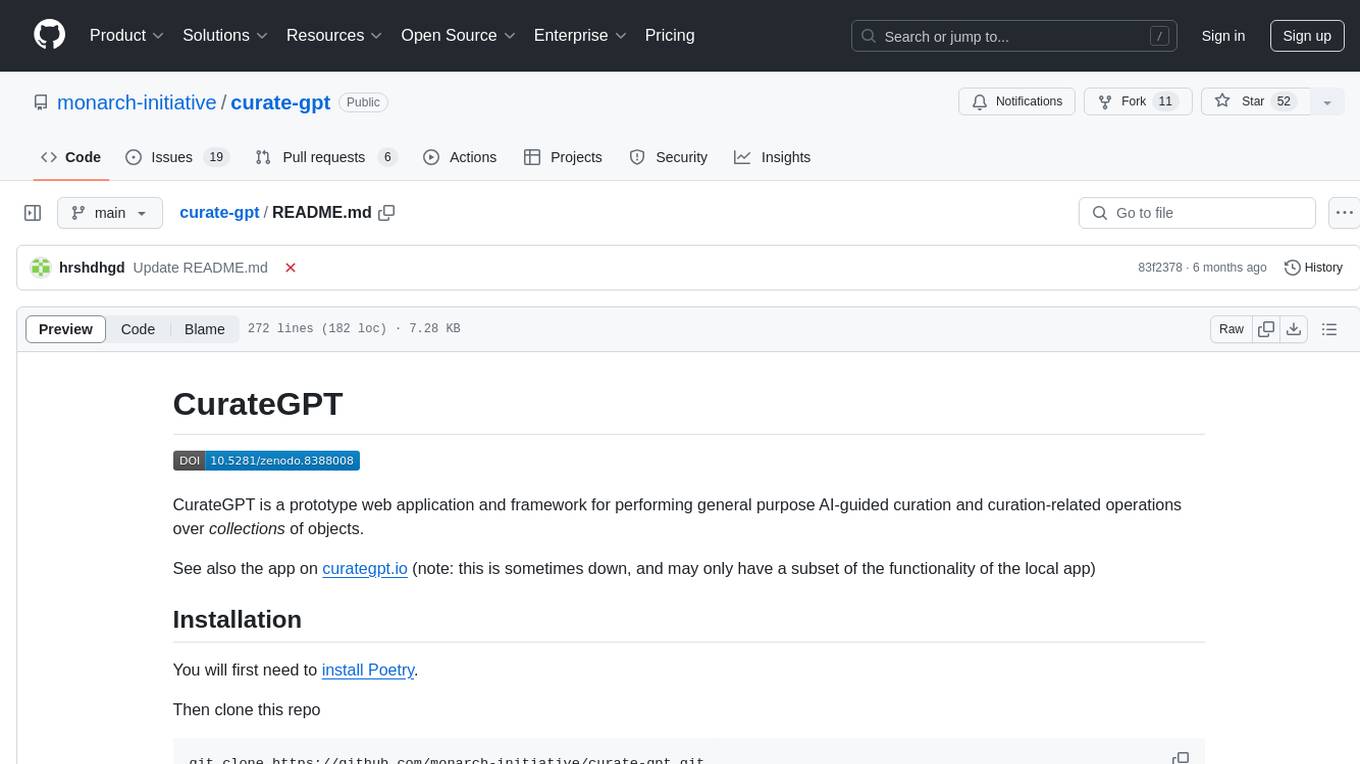
curate-gpt
CurateGPT is a prototype web application and framework for performing general purpose AI-guided curation and curation-related operations over collections of objects. It allows users to load JSON, YAML, or CSV data, build vector database indexes for ontologies, and interact with various data sources like GitHub, Google Drives, Google Sheets, and more. The tool supports ontology curation, knowledge base querying, term autocompletion, and all-by-all comparisons for objects in a collection.
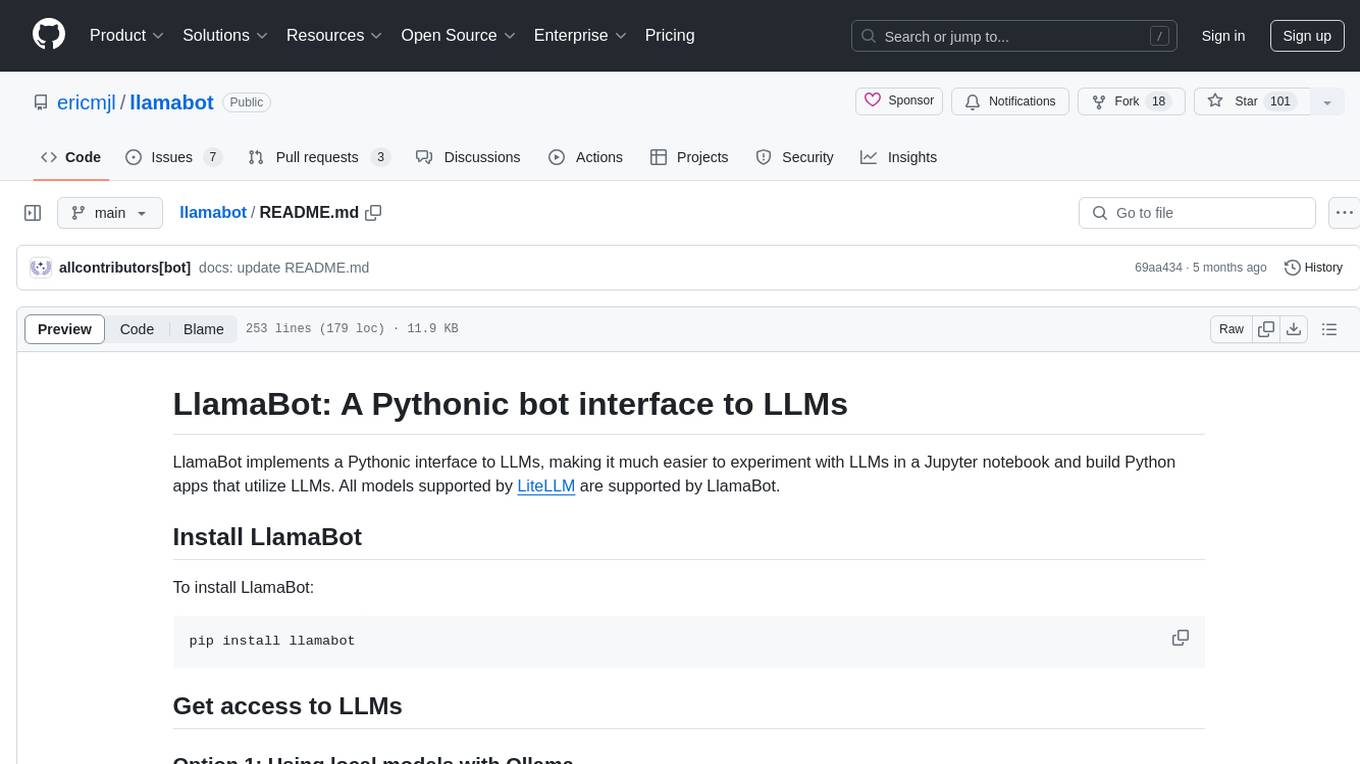
llamabot
LlamaBot is a Pythonic bot interface to Large Language Models (LLMs), providing an easy way to experiment with LLMs in Jupyter notebooks and build Python apps utilizing LLMs. It supports all models available in LiteLLM. Users can access LLMs either through local models with Ollama or by using API providers like OpenAI and Mistral. LlamaBot offers different bot interfaces like SimpleBot, ChatBot, QueryBot, and ImageBot for various tasks such as rephrasing text, maintaining chat history, querying documents, and generating images. The tool also includes CLI demos showcasing its capabilities and supports contributions for new features and bug reports from the community.
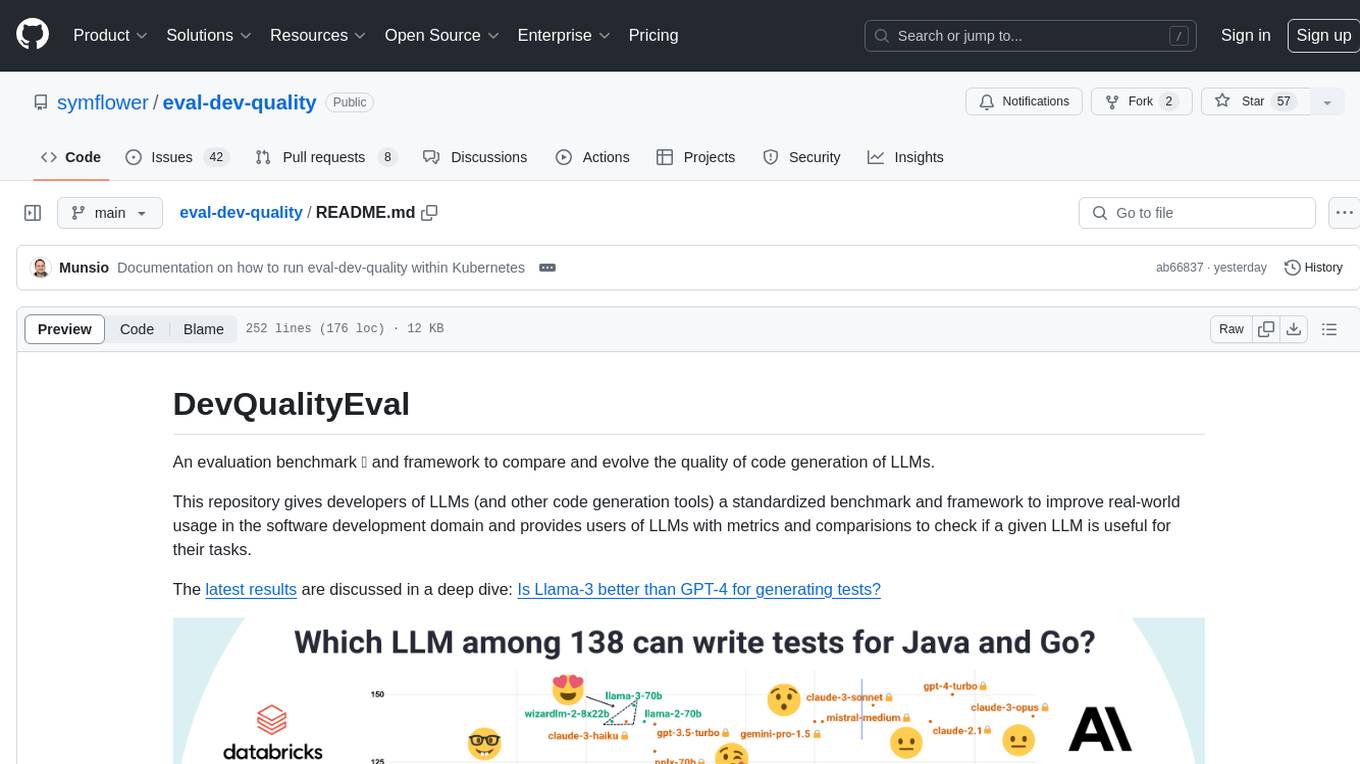
eval-dev-quality
DevQualityEval is an evaluation benchmark and framework designed to compare and improve the quality of code generation of Language Model Models (LLMs). It provides developers with a standardized benchmark to enhance real-world usage in software development and offers users metrics and comparisons to assess the usefulness of LLMs for their tasks. The tool evaluates LLMs' performance in solving software development tasks and measures the quality of their results through a point-based system. Users can run specific tasks, such as test generation, across different programming languages to evaluate LLMs' language understanding and code generation capabilities.
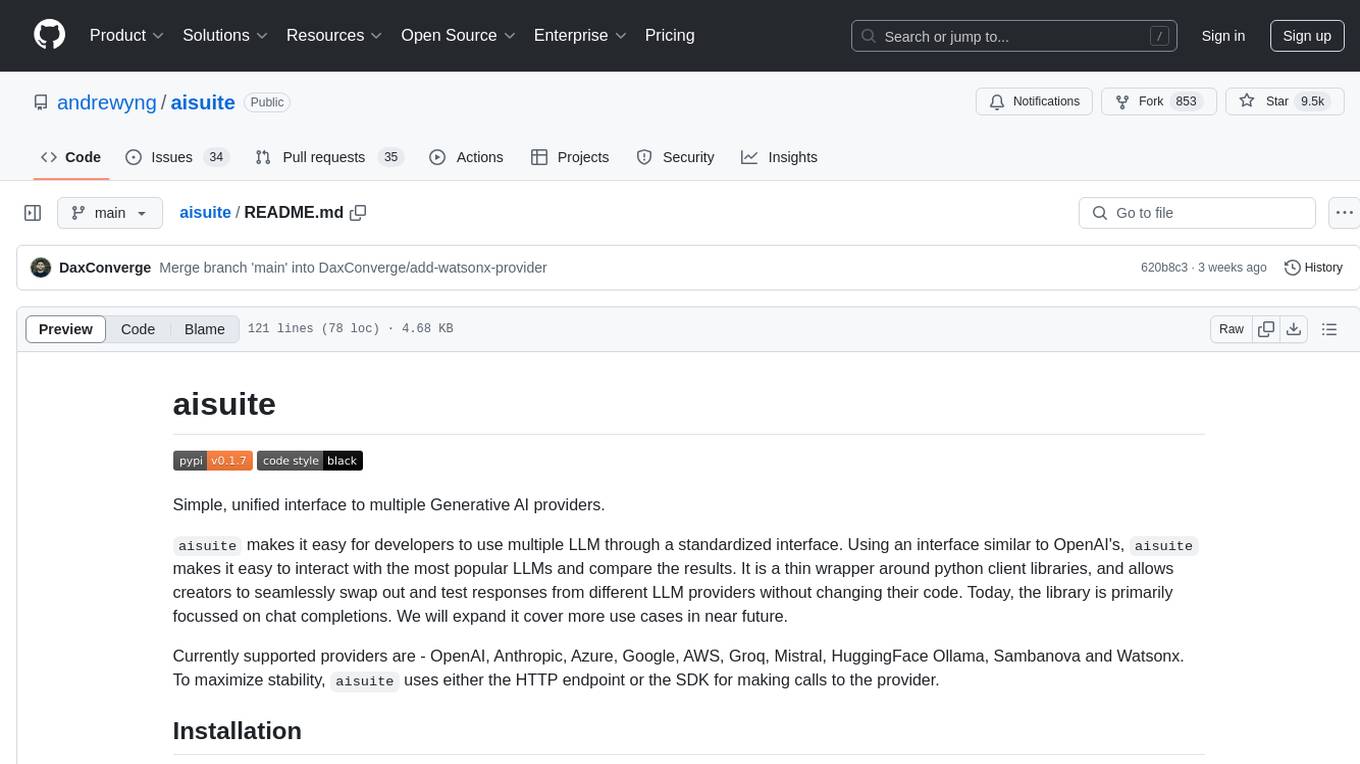
aisuite
Aisuite is a simple, unified interface to multiple Generative AI providers. It allows developers to easily interact with various Language Model (LLM) providers like OpenAI, Anthropic, Azure, Google, AWS, and more through a standardized interface. The library focuses on chat completions and provides a thin wrapper around python client libraries, enabling creators to test responses from different LLM providers without changing their code. Aisuite maximizes stability by using HTTP endpoints or SDKs for making calls to the providers. Users can install the base package or specific provider packages, set up API keys, and utilize the library to generate chat completion responses from different models.
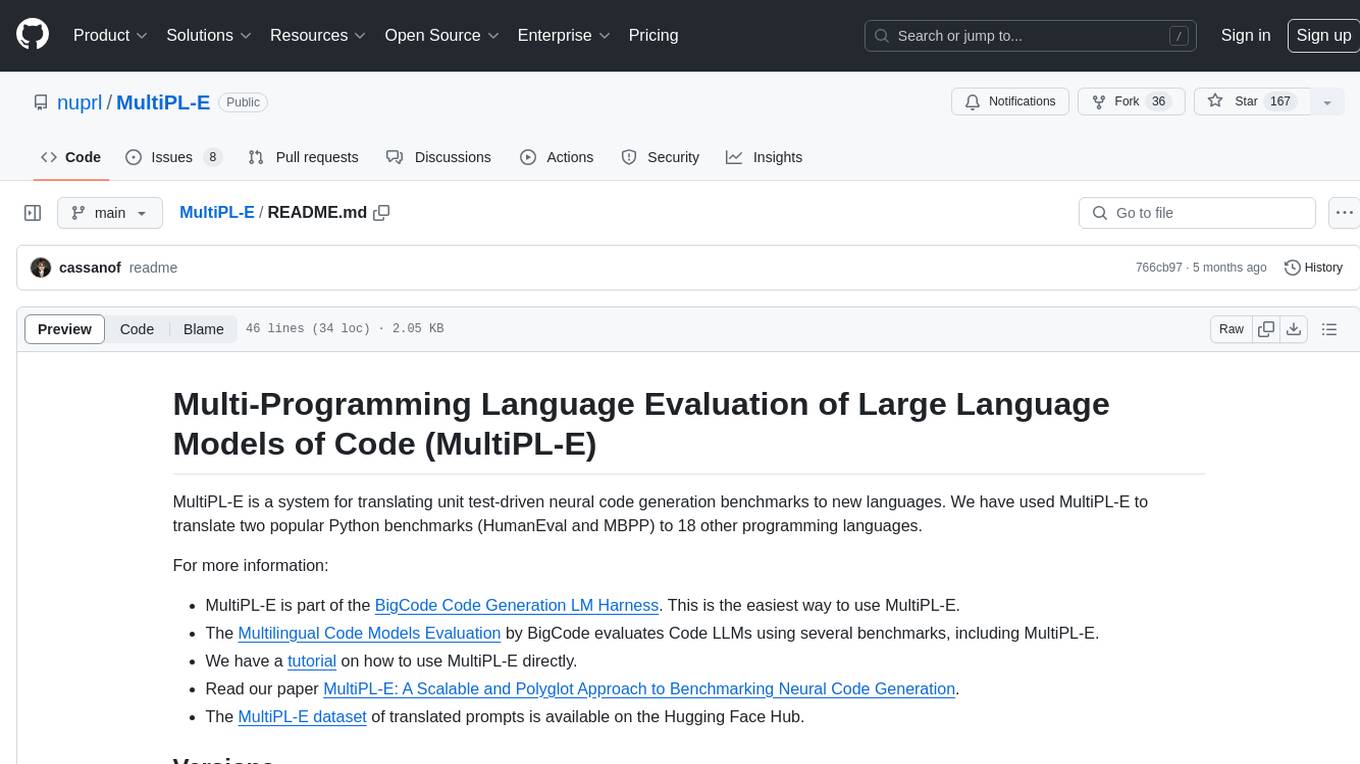
MultiPL-E
MultiPL-E is a system for translating unit test-driven neural code generation benchmarks to new languages. It is part of the BigCode Code Generation LM Harness and allows for evaluating Code LLMs using various benchmarks. The tool supports multiple versions with improvements and new language additions, providing a scalable and polyglot approach to benchmarking neural code generation. Users can access a tutorial for direct usage and explore the dataset of translated prompts on the Hugging Face Hub.
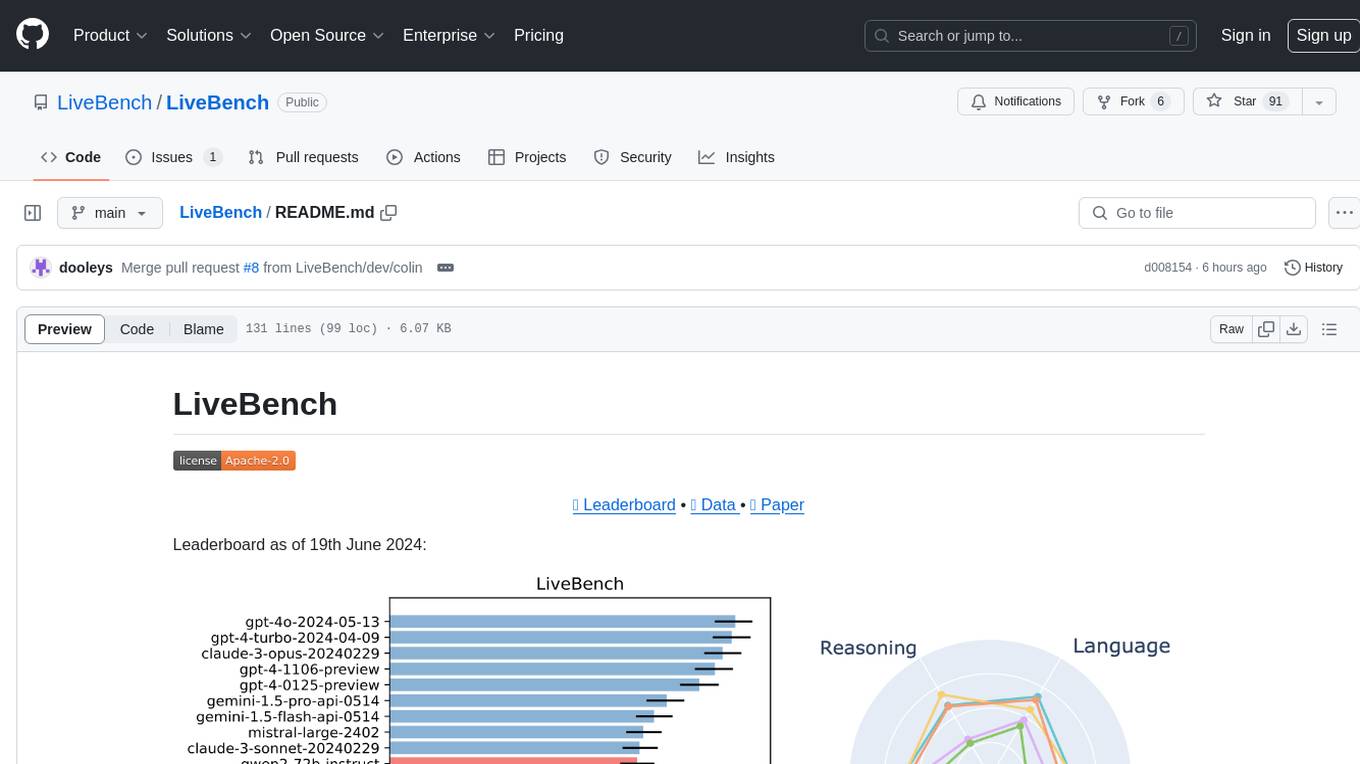
LiveBench
LiveBench is a benchmark tool designed for Language Model Models (LLMs) with a focus on limiting contamination through monthly new questions based on recent datasets, arXiv papers, news articles, and IMDb movie synopses. It provides verifiable, objective ground-truth answers for accurate scoring without an LLM judge. The tool offers 18 diverse tasks across 6 categories and promises to release more challenging tasks over time. LiveBench is built on FastChat's llm_judge module and incorporates code from LiveCodeBench and IFEval.
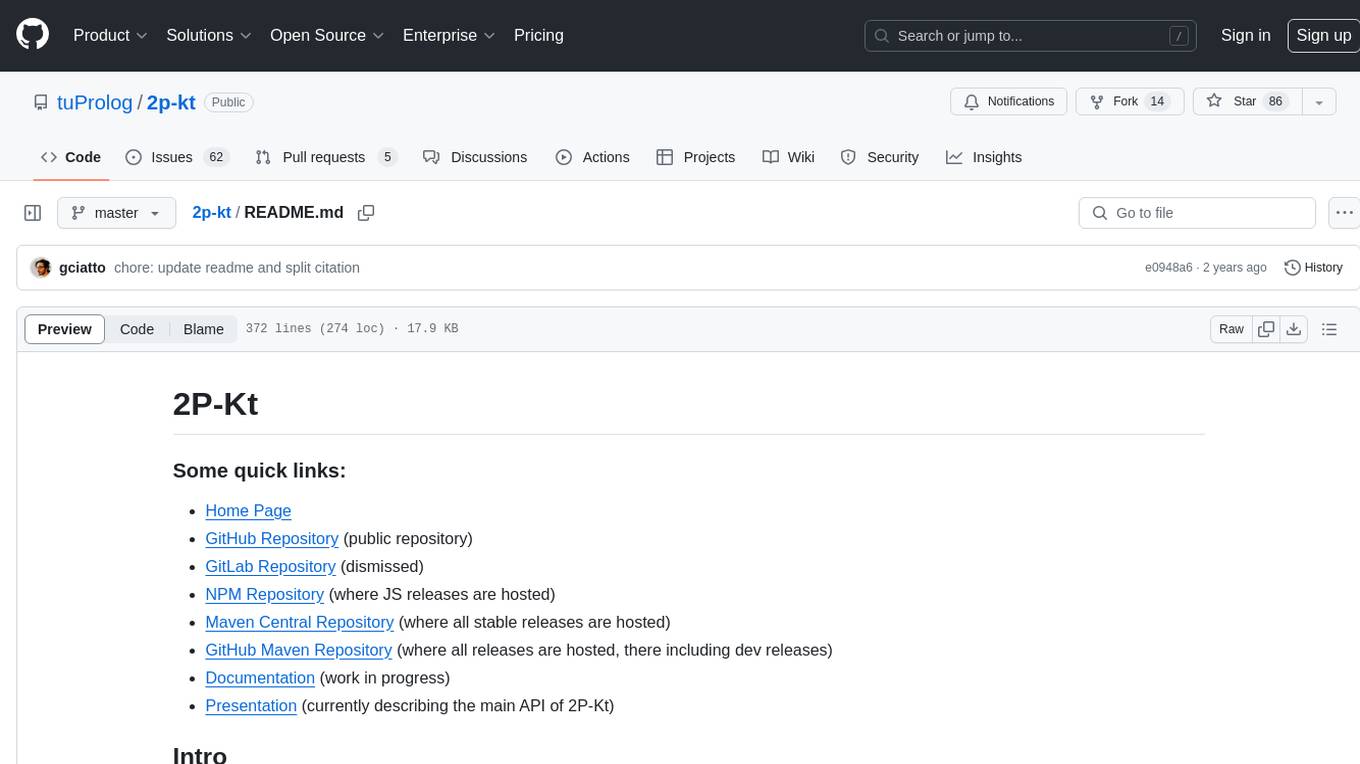
2p-kt
2P-Kt is a Kotlin-based and multi-platform reboot of tuProlog (2P), a multi-paradigm logic programming framework written in Java. It consists of an open ecosystem for Symbolic Artificial Intelligence (AI) with modules supporting logic terms, unification, indexing, resolution of logic queries, probabilistic logic programming, binary decision diagrams, OR-concurrent resolution, DSL for logic programming, parsing modules, serialisation modules, command-line interface, and graphical user interface. The tool is designed to support knowledge representation and automatic reasoning through logic programming in an extensible and flexible way, encouraging extensions towards other symbolic AI systems than Prolog. It is a pure, multi-platform Kotlin project supporting JVM, JS, Android, and Native platforms, with a lightweight library leveraging the Kotlin common library.
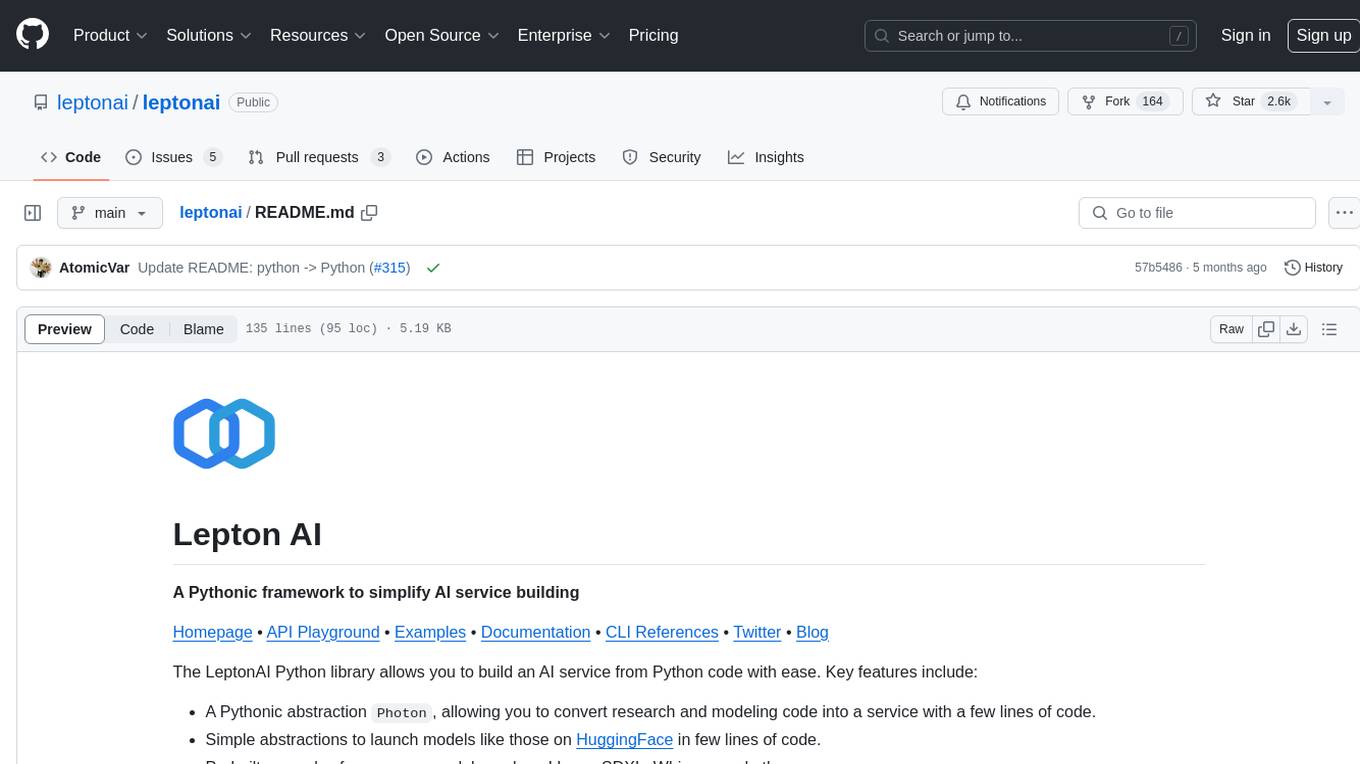
leptonai
A Pythonic framework to simplify AI service building. The LeptonAI Python library allows you to build an AI service from Python code with ease. Key features include a Pythonic abstraction Photon, simple abstractions to launch models like those on HuggingFace, prebuilt examples for common models, AI tailored batteries, a client to automatically call your service like native Python functions, and Pythonic configuration specs to be readily shipped in a cloud environment.
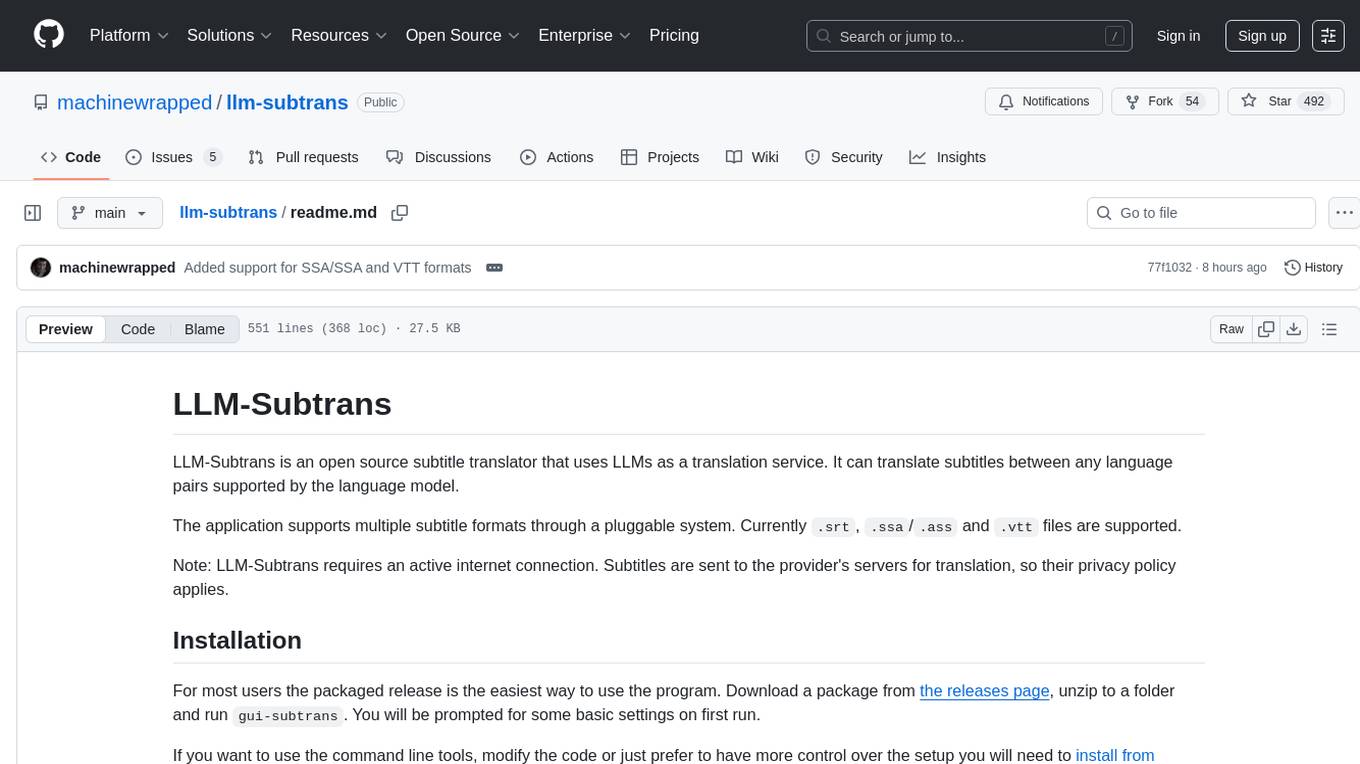
llm-subtrans
LLM-Subtrans is an open source subtitle translator that utilizes LLMs as a translation service. It supports translating subtitles between any language pairs supported by the language model. The application offers multiple subtitle formats support through a pluggable system, including .srt, .ssa/.ass, and .vtt files. Users can choose to use the packaged release for easy usage or install from source for more control over the setup. The tool requires an active internet connection as subtitles are sent to translation service providers' servers for translation.
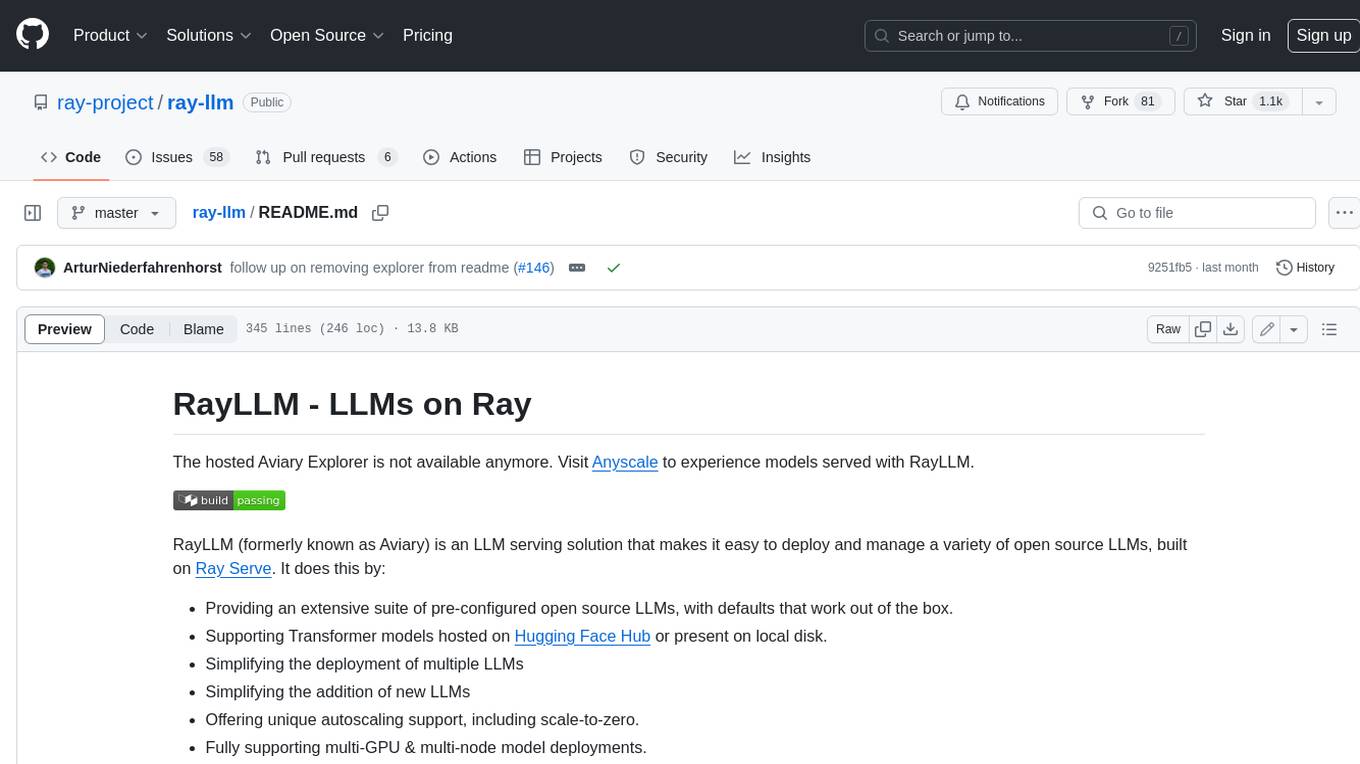
ray-llm
RayLLM (formerly known as Aviary) is an LLM serving solution that makes it easy to deploy and manage a variety of open source LLMs, built on Ray Serve. It provides an extensive suite of pre-configured open source LLMs, with defaults that work out of the box. RayLLM supports Transformer models hosted on Hugging Face Hub or present on local disk. It simplifies the deployment of multiple LLMs, the addition of new LLMs, and offers unique autoscaling support, including scale-to-zero. RayLLM fully supports multi-GPU & multi-node model deployments and offers high performance features like continuous batching, quantization and streaming. It provides a REST API that is similar to OpenAI's to make it easy to migrate and cross test them. RayLLM supports multiple LLM backends out of the box, including vLLM and TensorRT-LLM.
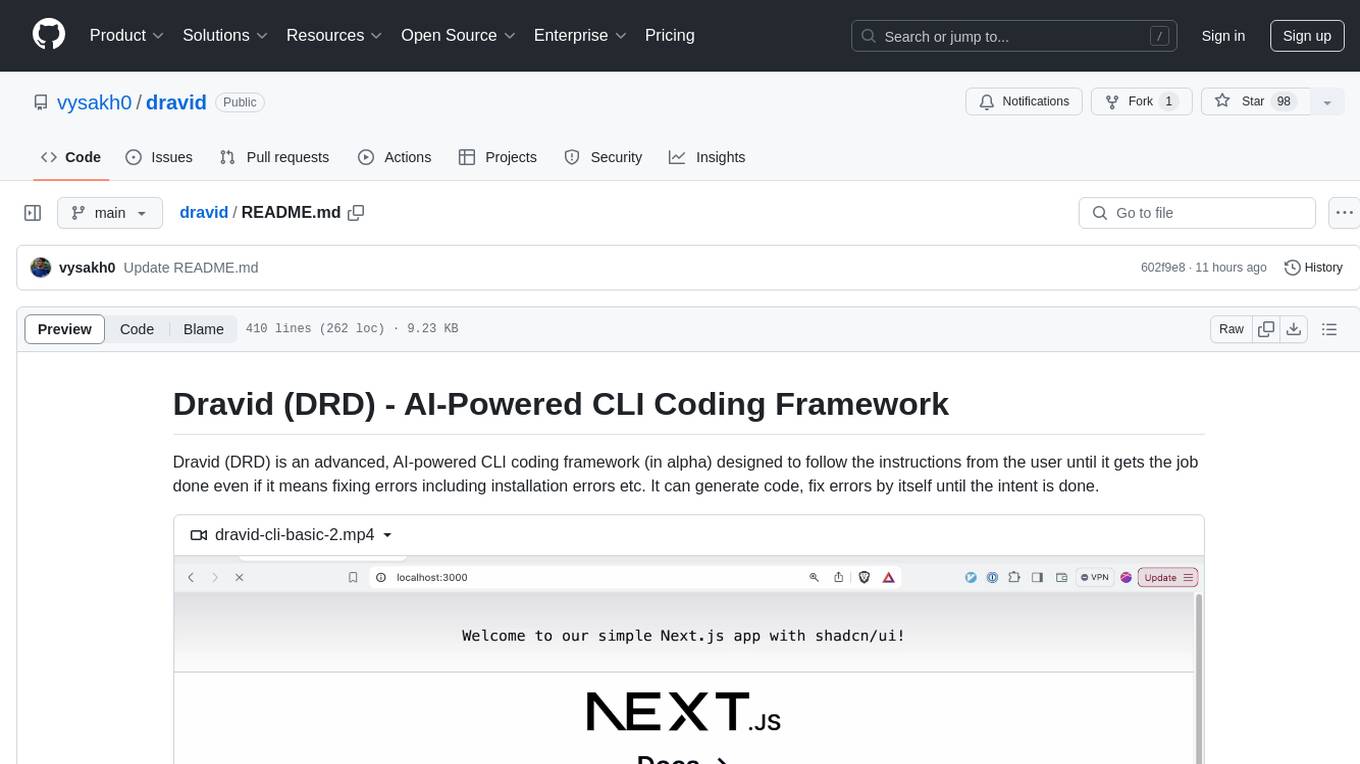
dravid
Dravid (DRD) is an advanced, AI-powered CLI coding framework designed to follow user instructions until the job is completed, including fixing errors. It can generate code, fix errors, handle image queries, manage file operations, integrate with external APIs, and provide a development server with error handling. Dravid is extensible and requires Python 3.7+ and CLAUDE_API_KEY. Users can interact with Dravid through CLI commands for various tasks like creating projects, asking questions, generating content, handling metadata, and file-specific queries. It supports use cases like Next.js project development, working with existing projects, exploring new languages, Ruby on Rails project development, and Python project development. Dravid's project structure includes directories for source code, CLI modules, API interaction, utility functions, AI prompt templates, metadata management, and tests. Contributions are welcome, and development setup involves cloning the repository, installing dependencies with Poetry, setting up environment variables, and using Dravid for project enhancements.
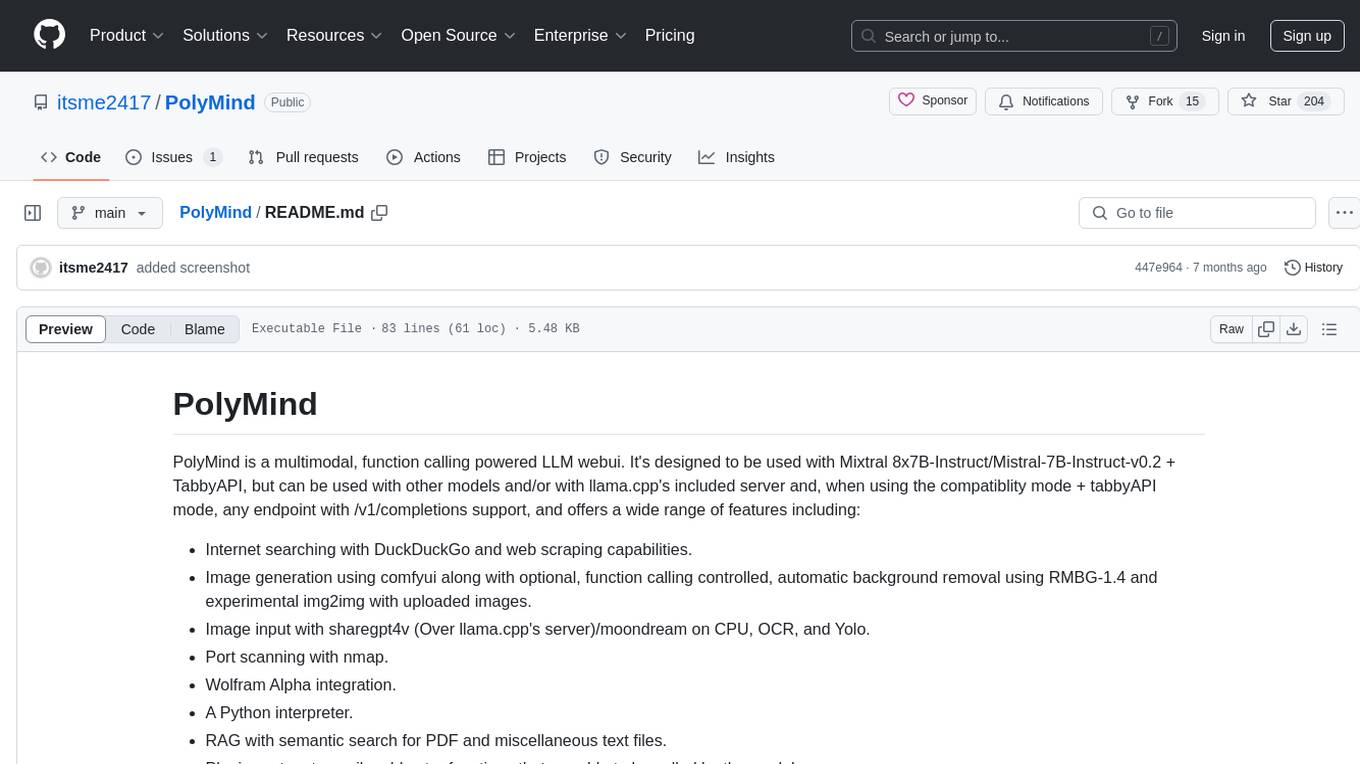
PolyMind
PolyMind is a multimodal, function calling powered LLM webui designed for various tasks such as internet searching, image generation, port scanning, Wolfram Alpha integration, Python interpretation, and semantic search. It offers a plugin system for adding extra functions and supports different models and endpoints. The tool allows users to interact via function calling and provides features like image input, image generation, and text file search. The application's configuration is stored in a `config.json` file with options for backend selection, compatibility mode, IP address settings, API key, and enabled features.
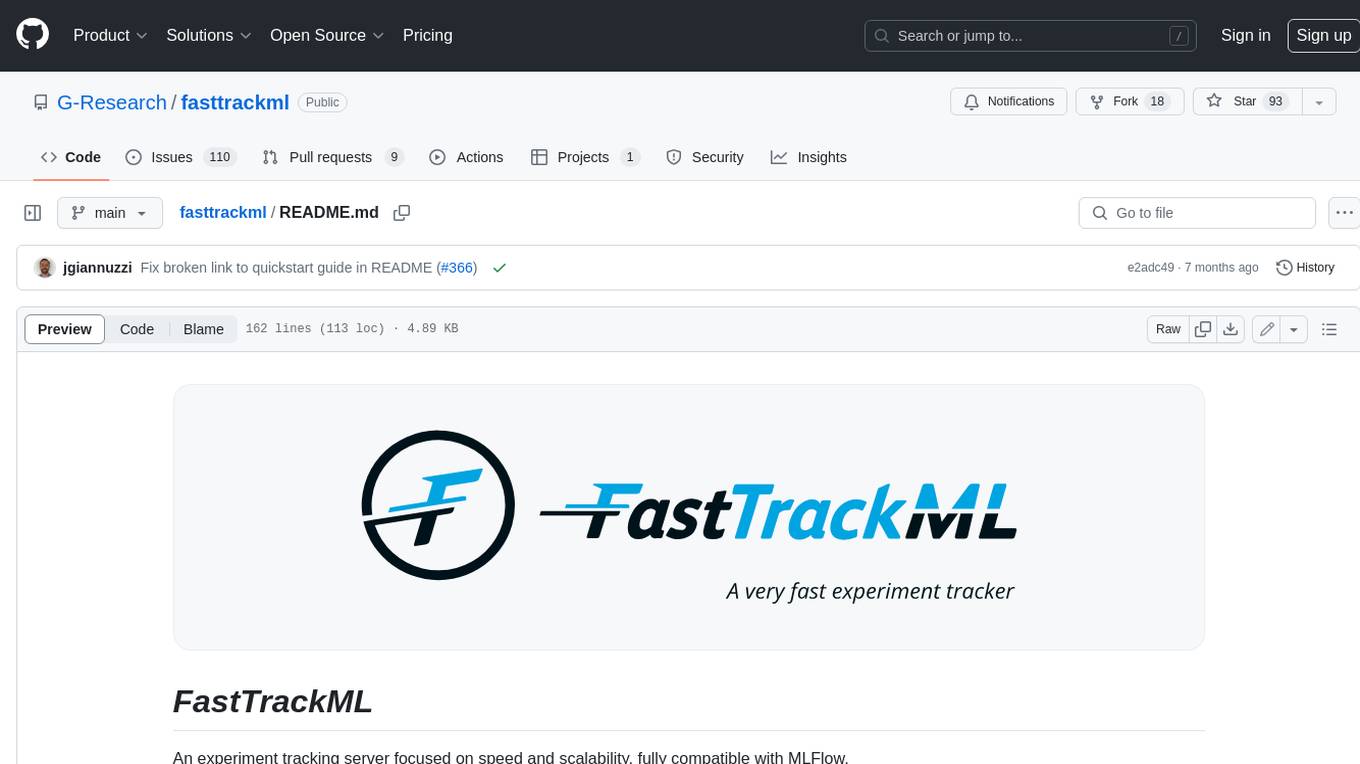
fasttrackml
FastTrackML is an experiment tracking server focused on speed and scalability, fully compatible with MLFlow. It provides a user-friendly interface to track and visualize your machine learning experiments, making it easy to compare different models and identify the best performing ones. FastTrackML is open source and can be easily installed and run with pip or Docker. It is also compatible with the MLFlow Python package, making it easy to integrate with your existing MLFlow workflows.
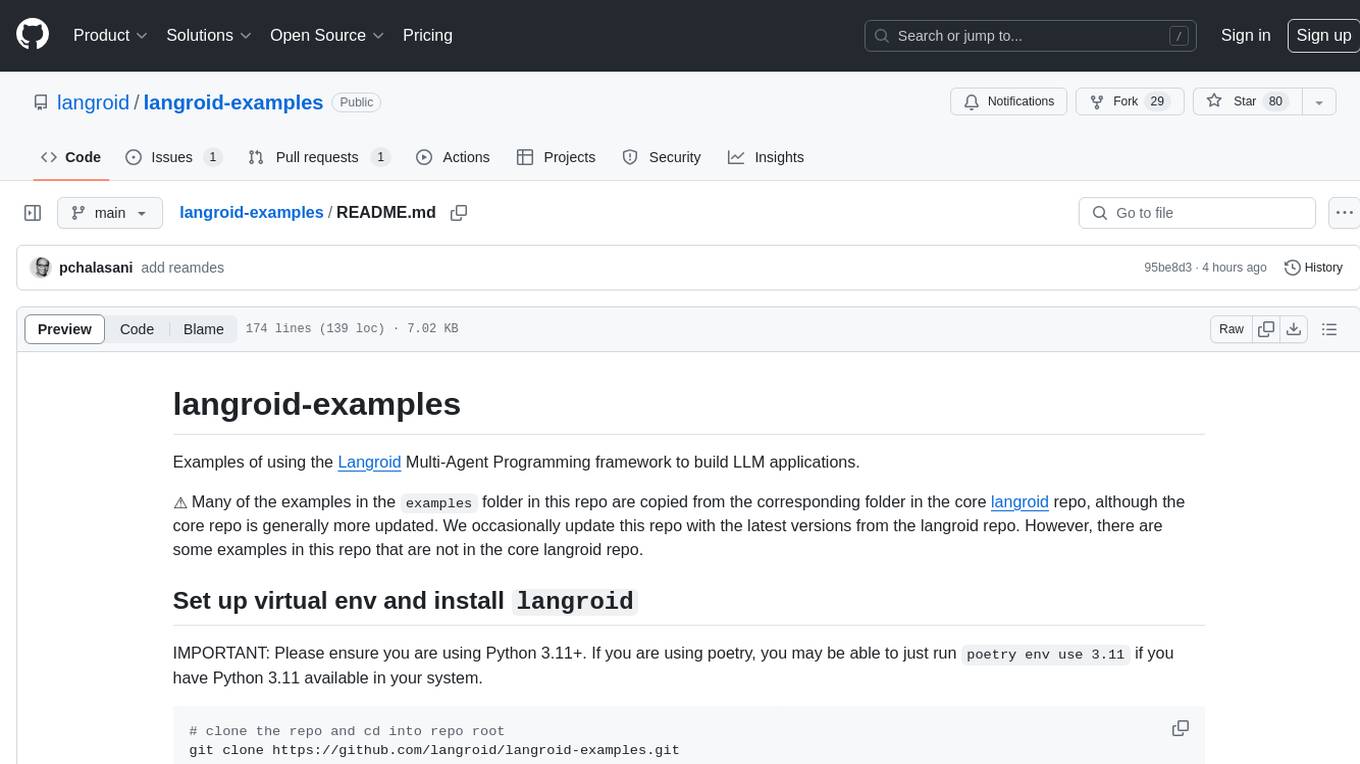
langroid-examples
Langroid-examples is a repository containing examples of using the Langroid Multi-Agent Programming framework to build LLM applications. It provides a collection of scripts and instructions for setting up the environment, working with local LLMs, using OpenAI LLMs, and running various examples. The repository also includes optional setup instructions for integrating with Qdrant, Redis, Momento, GitHub, and Google Custom Search API. Users can explore different scenarios and functionalities of Langroid through the provided examples and documentation.
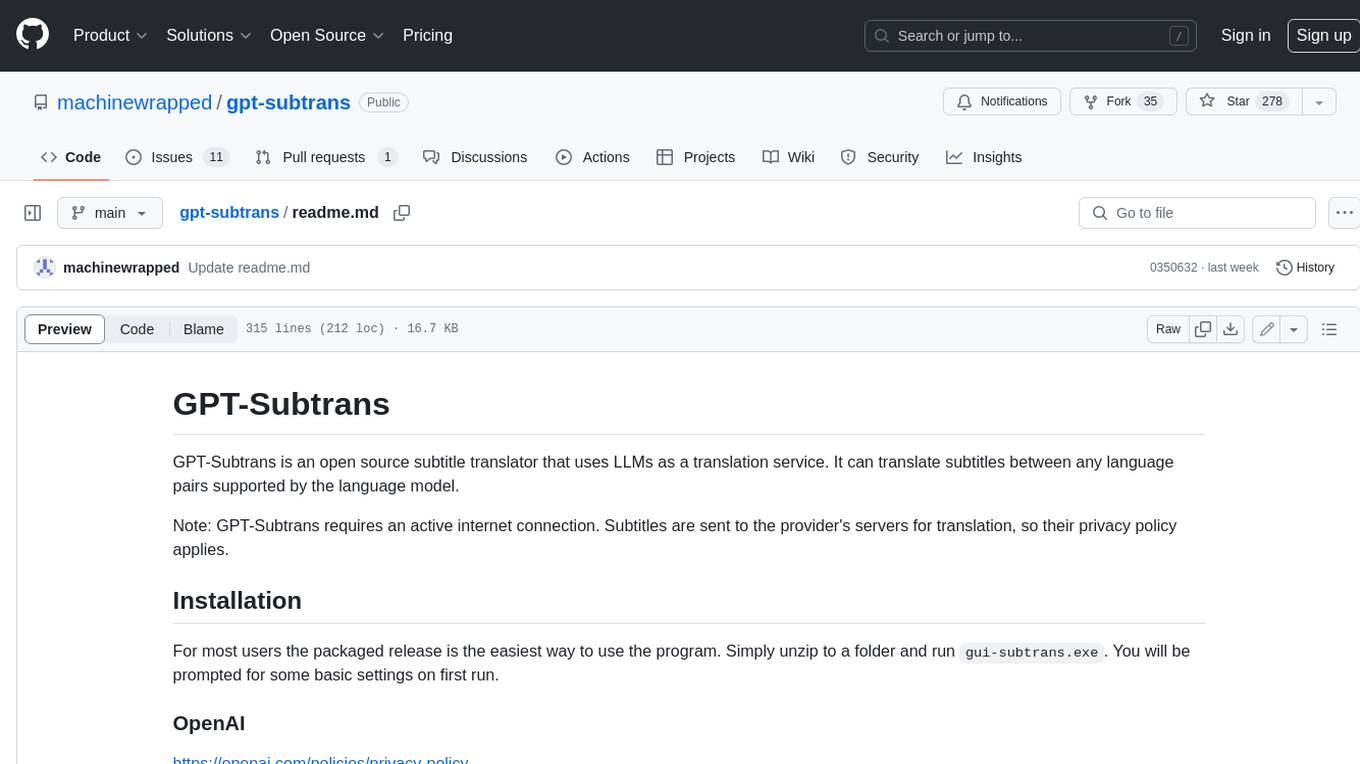
gpt-subtrans
GPT-Subtrans is an open-source subtitle translator that utilizes large language models (LLMs) as translation services. It supports translation between any language pairs that the language model supports. Note that GPT-Subtrans requires an active internet connection, as subtitles are sent to the provider's servers for translation, and their privacy policy applies.
For similar tasks

curate-gpt
CurateGPT is a prototype web application and framework for performing general purpose AI-guided curation and curation-related operations over collections of objects. It allows users to load JSON, YAML, or CSV data, build vector database indexes for ontologies, and interact with various data sources like GitHub, Google Drives, Google Sheets, and more. The tool supports ontology curation, knowledge base querying, term autocompletion, and all-by-all comparisons for objects in a collection.

curategpt
CurateGPT is a prototype web application and framework designed for general purpose AI-guided curation and curation-related operations over collections of objects. It provides functionalities for loading example data, building indexes, interacting with knowledge bases, and performing tasks such as chatting with a knowledge base, querying Pubmed, interacting with a GitHub issue tracker, term autocompletion, and all-by-all comparisons. The tool is built to work best with the OpenAI gpt-4 model and OpenAI ada-text-embedding-002 for embedding, but also supports alternative models through a plugin architecture.
For similar jobs
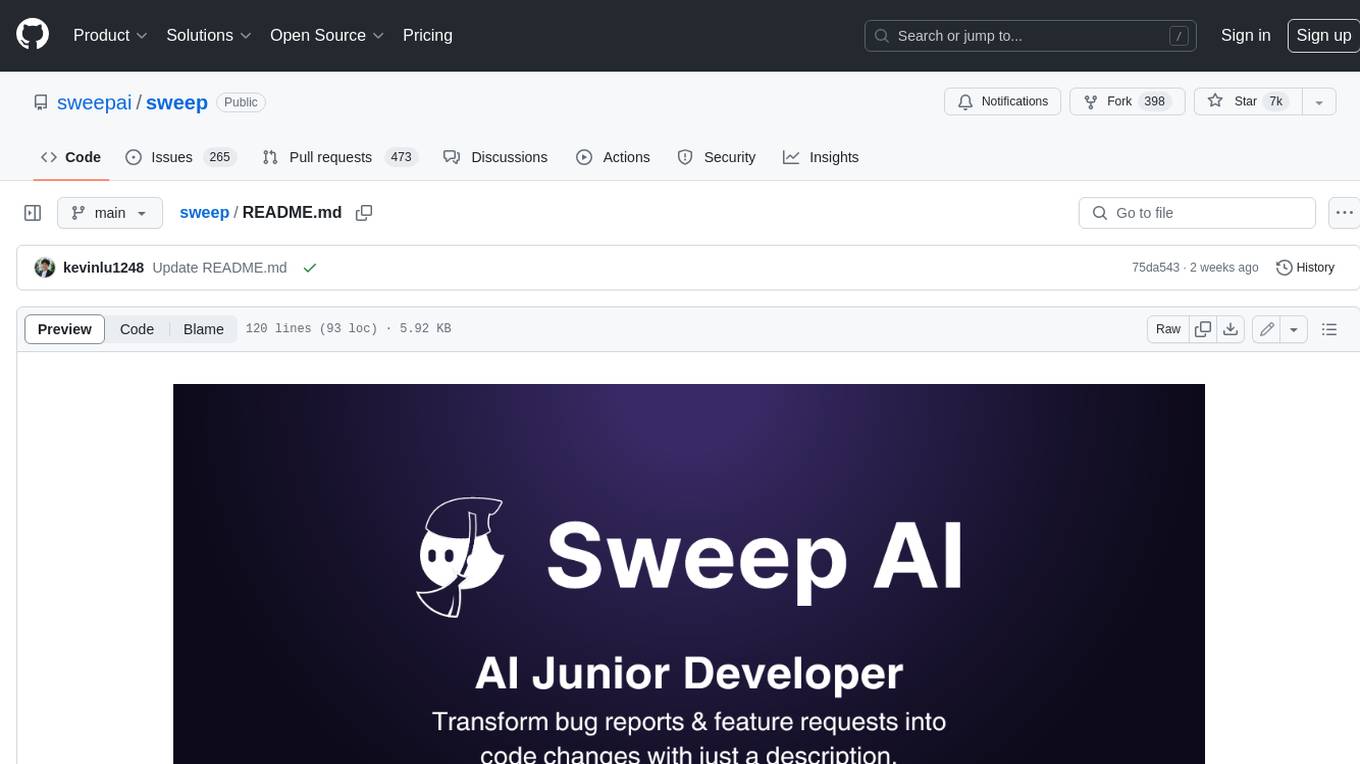
sweep
Sweep is an AI junior developer that turns bugs and feature requests into code changes. It automatically handles developer experience improvements like adding type hints and improving test coverage.
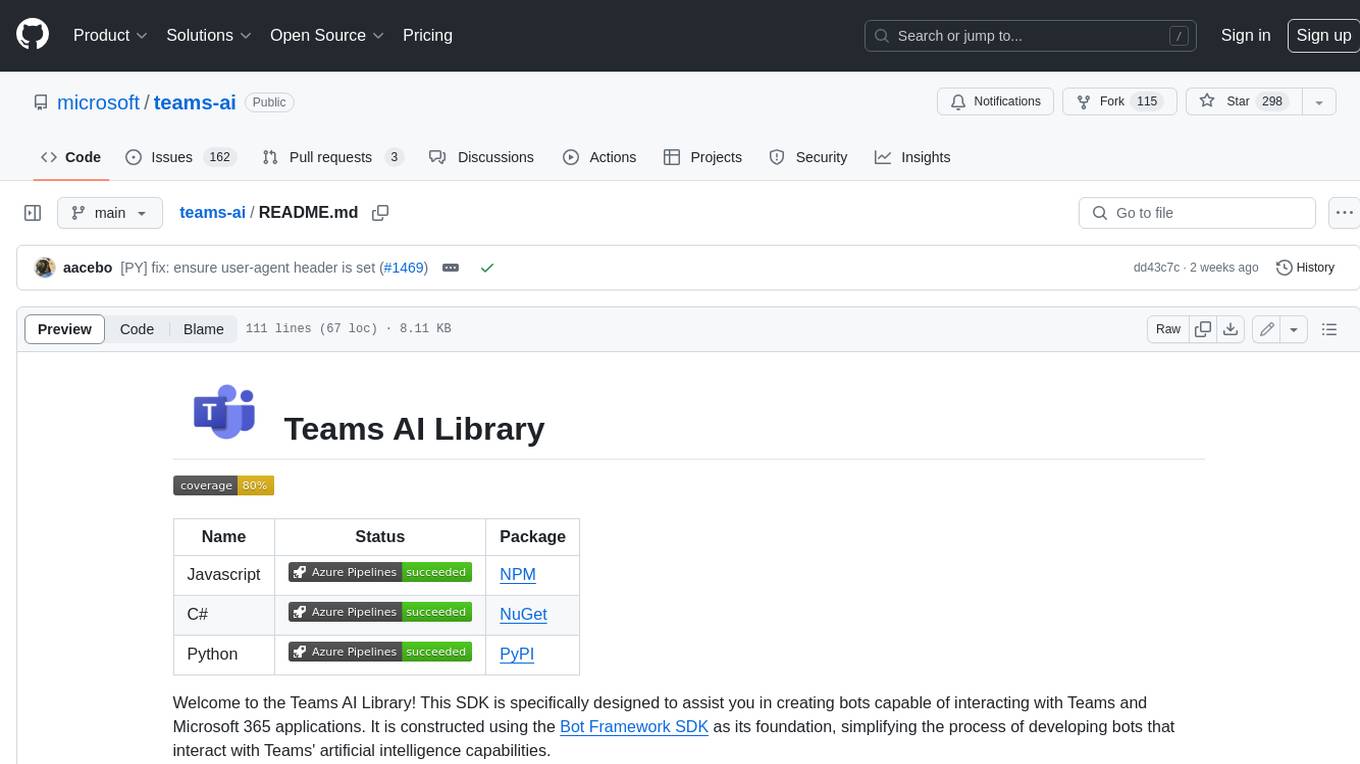
teams-ai
The Teams AI Library is a software development kit (SDK) that helps developers create bots that can interact with Teams and Microsoft 365 applications. It is built on top of the Bot Framework SDK and simplifies the process of developing bots that interact with Teams' artificial intelligence capabilities. The SDK is available for JavaScript/TypeScript, .NET, and Python.
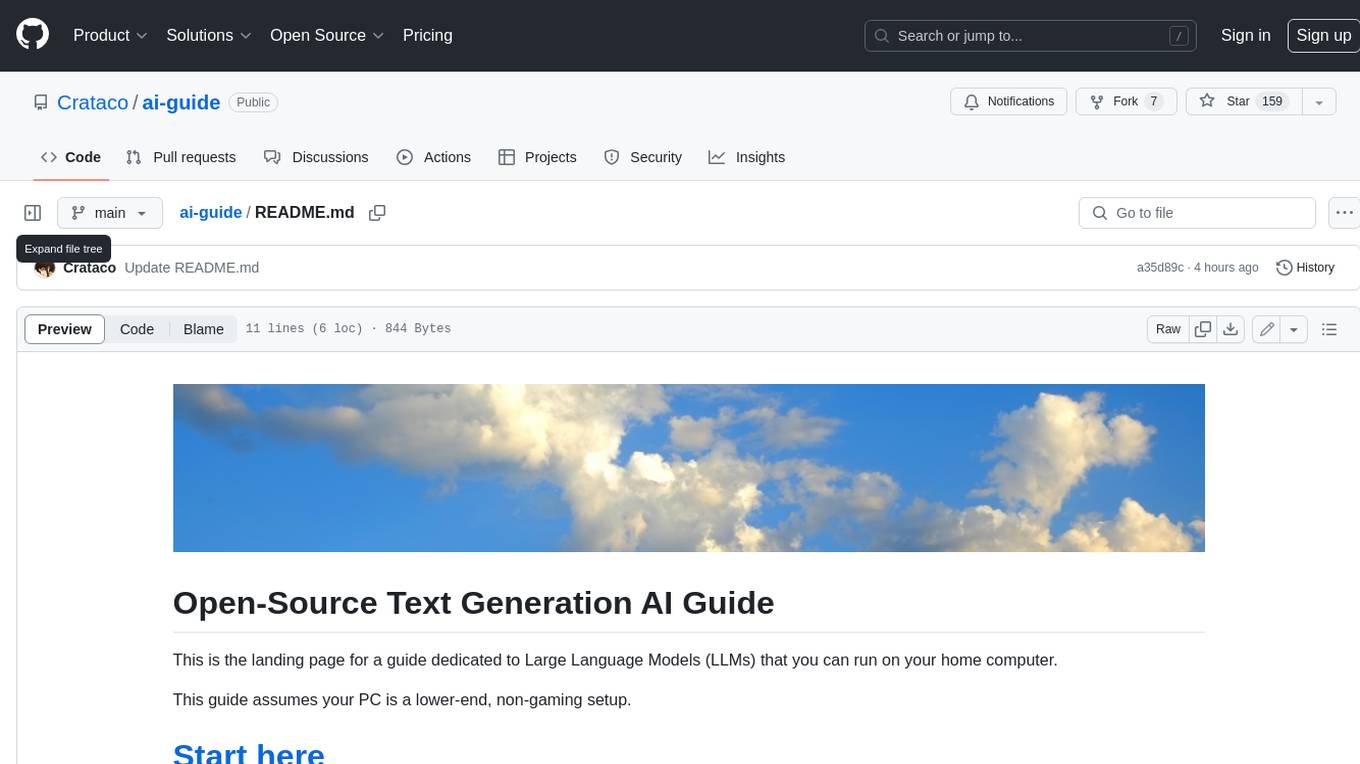
ai-guide
This guide is dedicated to Large Language Models (LLMs) that you can run on your home computer. It assumes your PC is a lower-end, non-gaming setup.
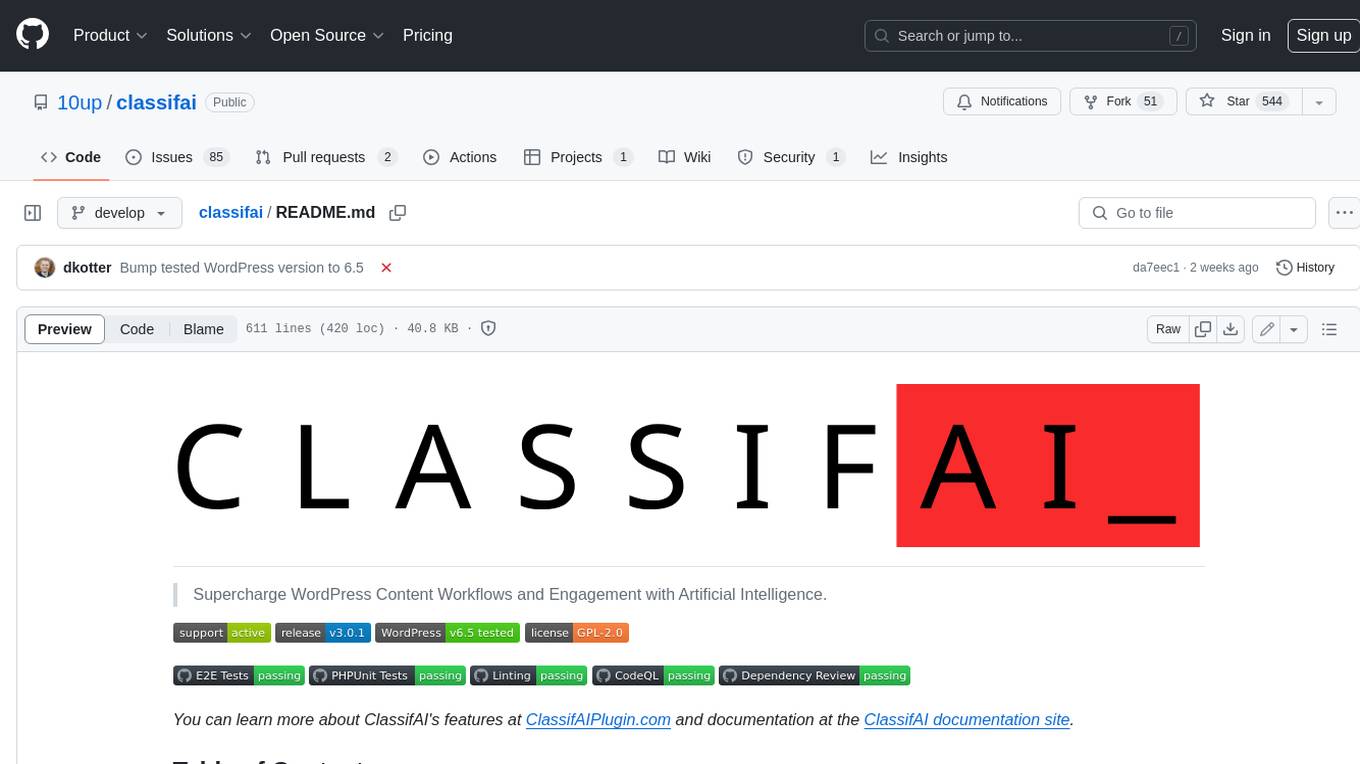
classifai
Supercharge WordPress Content Workflows and Engagement with Artificial Intelligence. Tap into leading cloud-based services like OpenAI, Microsoft Azure AI, Google Gemini and IBM Watson to augment your WordPress-powered websites. Publish content faster while improving SEO performance and increasing audience engagement. ClassifAI integrates Artificial Intelligence and Machine Learning technologies to lighten your workload and eliminate tedious tasks, giving you more time to create original content that matters.
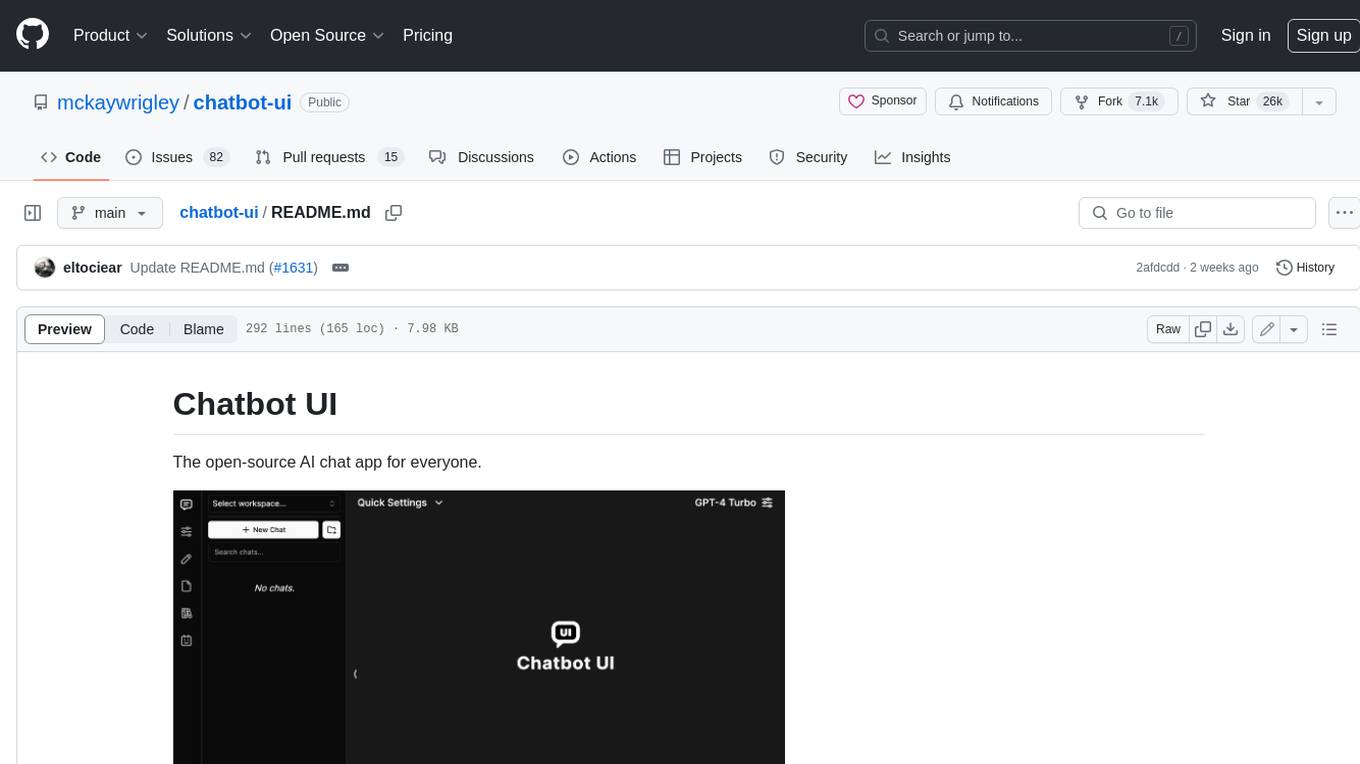
chatbot-ui
Chatbot UI is an open-source AI chat app that allows users to create and deploy their own AI chatbots. It is easy to use and can be customized to fit any need. Chatbot UI is perfect for businesses, developers, and anyone who wants to create a chatbot.
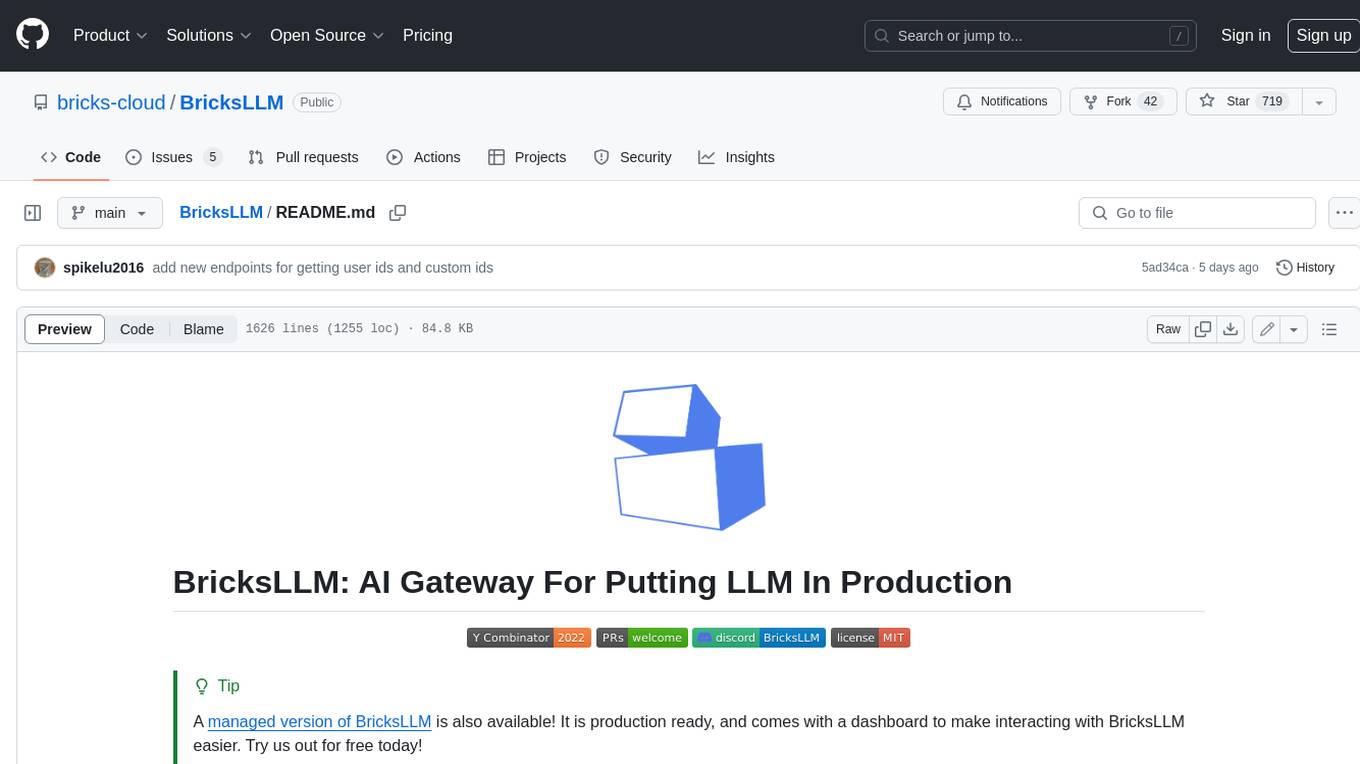
BricksLLM
BricksLLM is a cloud native AI gateway written in Go. Currently, it provides native support for OpenAI, Anthropic, Azure OpenAI and vLLM. BricksLLM aims to provide enterprise level infrastructure that can power any LLM production use cases. Here are some use cases for BricksLLM: * Set LLM usage limits for users on different pricing tiers * Track LLM usage on a per user and per organization basis * Block or redact requests containing PIIs * Improve LLM reliability with failovers, retries and caching * Distribute API keys with rate limits and cost limits for internal development/production use cases * Distribute API keys with rate limits and cost limits for students
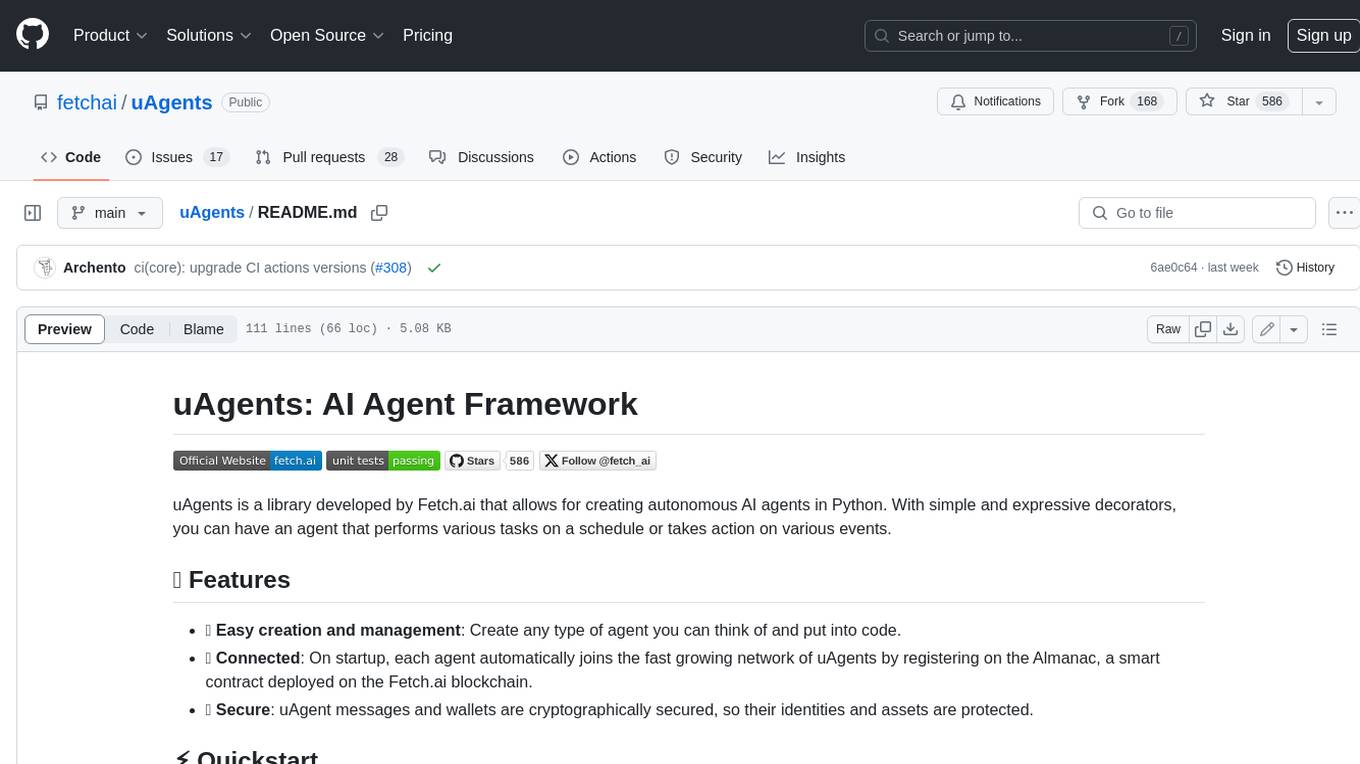
uAgents
uAgents is a Python library developed by Fetch.ai that allows for the creation of autonomous AI agents. These agents can perform various tasks on a schedule or take action on various events. uAgents are easy to create and manage, and they are connected to a fast-growing network of other uAgents. They are also secure, with cryptographically secured messages and wallets.
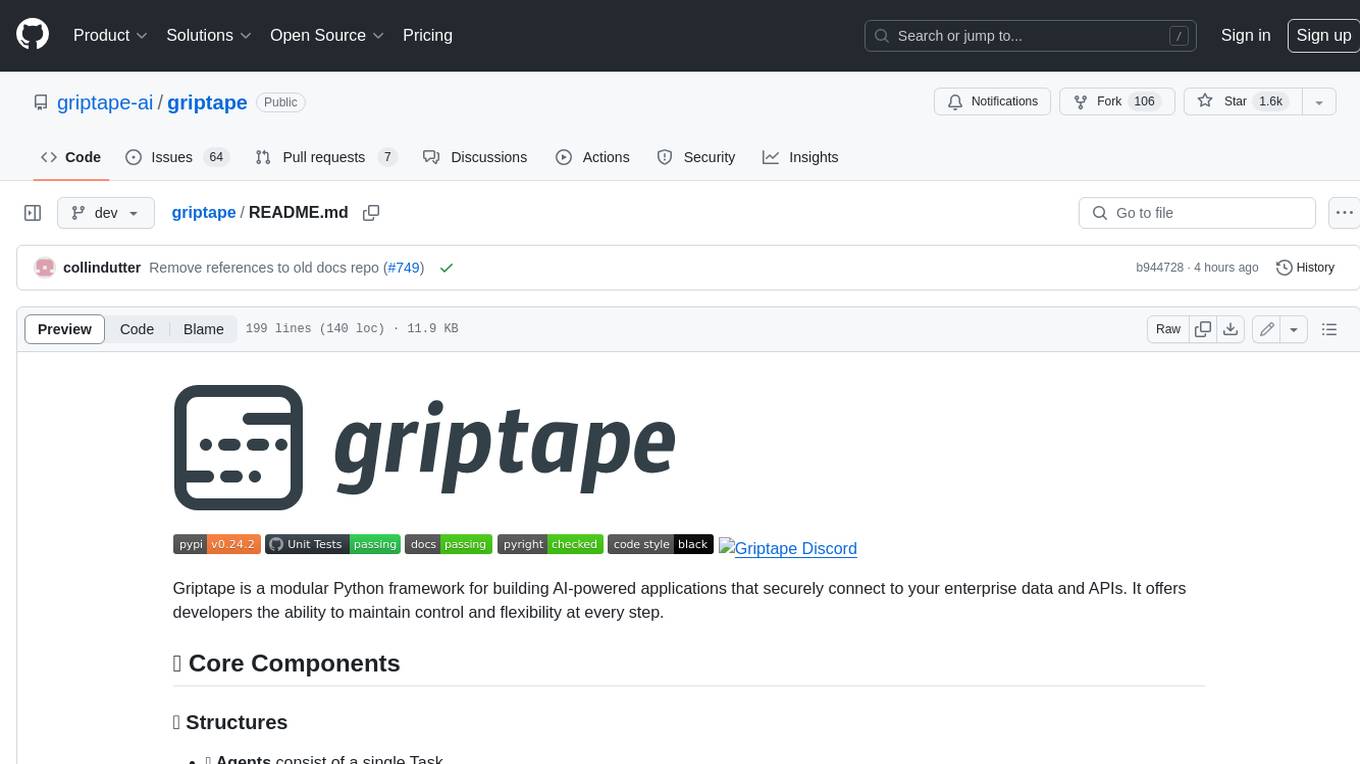
griptape
Griptape is a modular Python framework for building AI-powered applications that securely connect to your enterprise data and APIs. It offers developers the ability to maintain control and flexibility at every step. Griptape's core components include Structures (Agents, Pipelines, and Workflows), Tasks, Tools, Memory (Conversation Memory, Task Memory, and Meta Memory), Drivers (Prompt and Embedding Drivers, Vector Store Drivers, Image Generation Drivers, Image Query Drivers, SQL Drivers, Web Scraper Drivers, and Conversation Memory Drivers), Engines (Query Engines, Extraction Engines, Summary Engines, Image Generation Engines, and Image Query Engines), and additional components (Rulesets, Loaders, Artifacts, Chunkers, and Tokenizers). Griptape enables developers to create AI-powered applications with ease and efficiency.